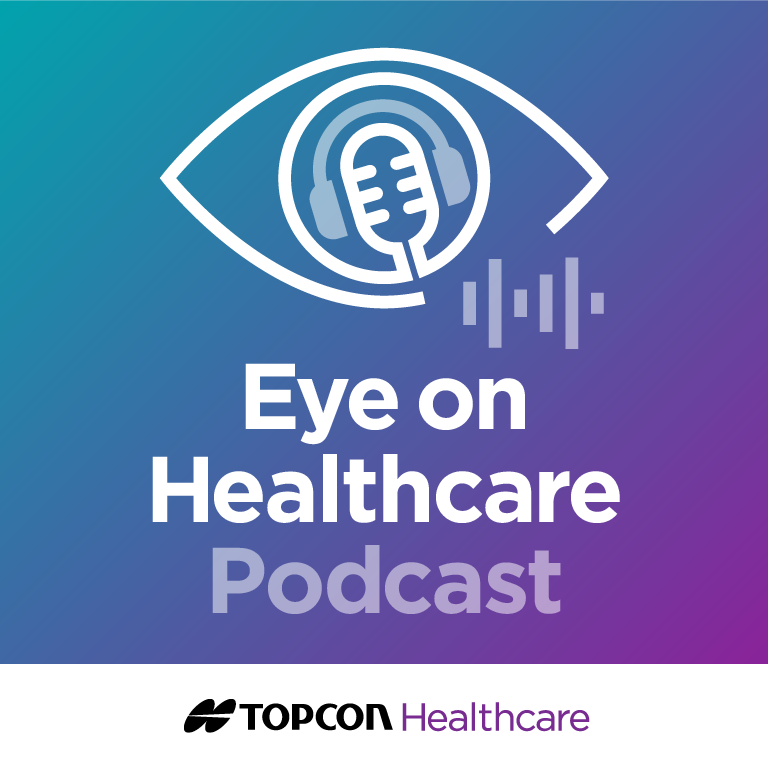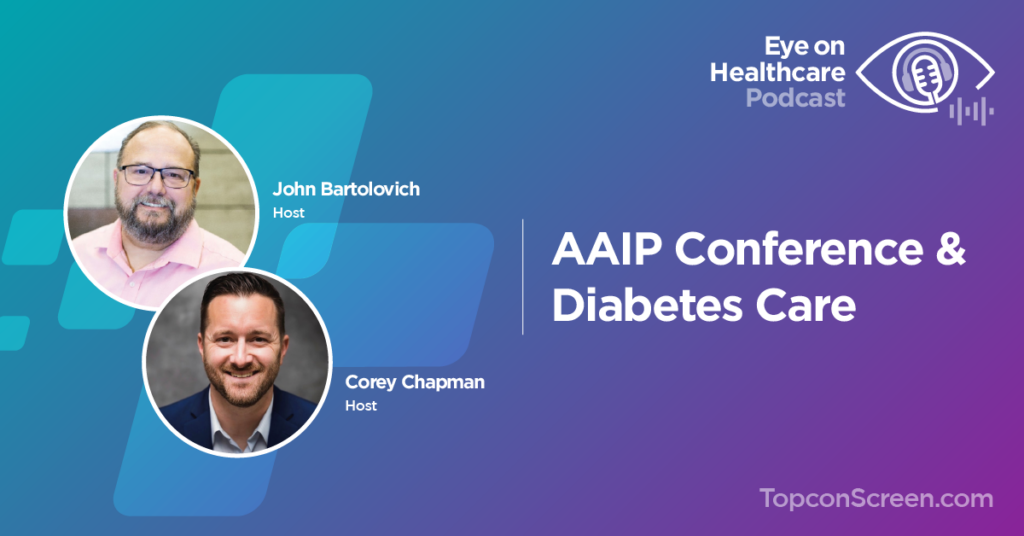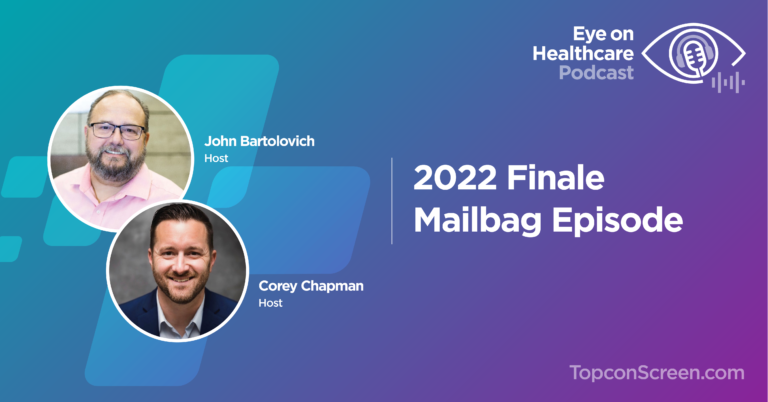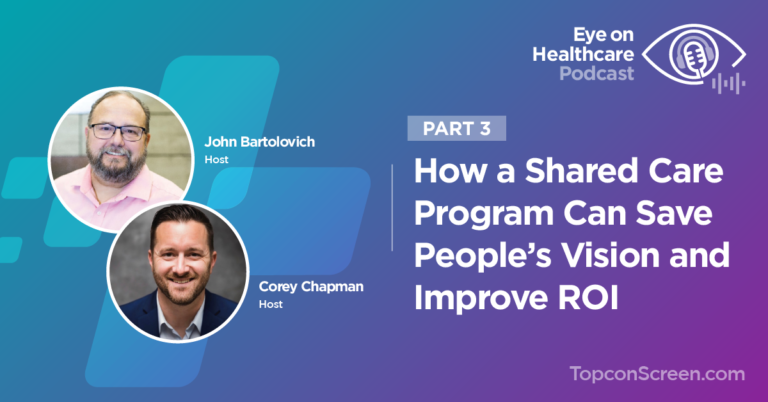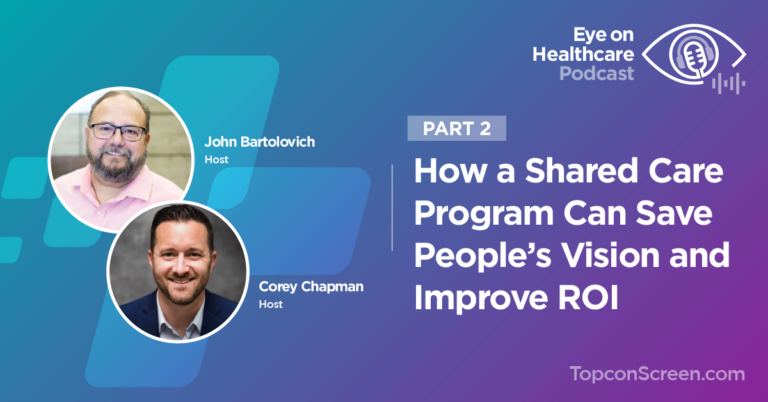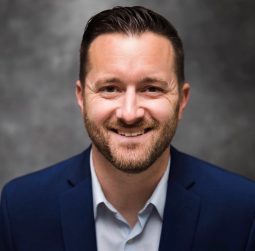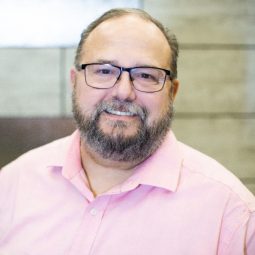Episode Transcript
John: Welcome to the Eye on Healthcare Podcast. This is one of your host John Bartolovich with Topcon and I will let me introduce my Cohost Corey Chapman and the reason I say Cohost today is, if you haven’t noticed, it’s another flip of the script where I will be asking the questions and Corey will be answering the questions. How are you today, Corey?
Corey: I did not agree to this. I just accidentally sat in the cohost seat today. So can we switch back? Is it too late?
John: It’s too late.
Corey: What? We’ll talk about it after this episode.
John: Yeah. But the reason we’re flipping the script is you recently attended a conference representing Topcon Screen in Washington DC and why don’t you tell us a little bit about it?
Corey: Yeah. Now last week I was fortunate to attend AAiPS annual conference in Washington DC like you mentioned, this year’s theme was optimizing American Indian and Alaska Native Health, implementing our tribal nation sovereignty. Now we were a vendor so we were, we were you know, sequestered in that vendor room. Reading through the panel and the guide was great because they had sessions around social determinants of health. Ding Ding when ready.
John: Something we talk about a lot
Corey: yeah, yeah, what about this one? Health equality for native communities, other thing we’ve talked about before. Cardiovascular risk factors in American Indian youth and also a traditional health approach in urban Indian health delivery. So we had great speakers, great discussions and really proud to be involved and be invited.
John: Well, that sounds great. Just adjust the backup. I can tell just from the description that we’re talking about Healthcare for Native Americans. But what exactly does AAiP stand for?
Corey: Yeah, I should have led with that. It’s the Association of American Indian Physicians. AAiP is a federally recognized nonprofit with a 501C3 status. Other membership is made-up of American Indian and Alaska Native physicians who are licensed to practice medicine in the US and one of the major goals of AAiP is to motivate American Indian and Alaska Native students to remain in the academic pipeline and pursue a career in health professions and or biomedical research, thereby increasing the number of American Indian and Alaska Native Medical professionals in the workforce. They strive to improve the overall health of American Indian and Alaska Native communities through a variety of programs. They have fostered several programs that directly address widely acknowledged disparities in their communities.
John: And, you know, I can believe that a lot of information that I research says that the Native American and Alaskan population has been left behind in a lot of ways when it comes to healthcare. Why would Topcon attend something like this?
Corey: Well, we’re always trying to reach out to every community that is affected by diabetes and unfortunately in the US, every community seems to be affected by diabetes. What I learned there is American Indians and Alaska natives have a higher burden of diabetes than any other race or ethnic group in the United States. A recent estimate shows 14.7 of these communities have diabetes versus 7.5 of non Hispanic whites1. So over just about double and you know additionally more often developing, disabling or life-threatening long-term complications from diabetes. Obviously diabetic retinopathy and DMV or complications of the poorly controlled diabetes, despite the availability of effective treatments to reduce vision loss, DR remains that leading cause of new blindness in people 18 to 64. So, so we preach a lot about it being the leading cause of blindness and working age adults across the US population, but it is even more of a burden with Native Americans. So, one other thing is that Indian Health Services, which is a federal agency primarily responsible for providing healthcare to the members of these communities, the funding to IHS is lower per capita than any other federal systems and expenditure per use of health care services was much lower in 2019 than previous years. So most of the IHS ambulatory care facilities are rural with limited availability of specialty providers and we know about the specialty providers, right?
John: Exactly. So does IHS provide any assistance for the diabetic eye exam?
Corey: Yeah. And maybe I should give a little bit extra background, right. So on IHS, and I apologize, I talk about it like we all know about it, but IHS is the Indian Health Service. It’s an agency within the Department of Health and Human Services. It’s responsible for providing federal health services to American Indians and Alaska natives. The provision of health services to the members are federally recognized tribes that grow out of the special government to government relationship between the federal government and Indian tribes. And yes, to answer your question, the Indian Health Service Joslin Vision Network Tele-Ophthalmology program was actually established way back in the year 2000. So, John, pause that for a second, let’s absorb that, the year 2000, we’re in 2022, we’re talking about this technology in primary care, it’s fairly new. Right? fairly young, 10 years young. Well Native Americans have been doing this type of service for 22 years so they know it’s tried and true. They do use the telemedicine technology to provide high quality, cost effective annual diabetic eye exams to their groups. Now, when patients with diabetes arrive at their appointment in the primary care clinic, technology obtains photos back of the eye. Without dilation, the photos are immediately sent to a reading center. Does this sound familiar, John? Where doctors interpret them and report any abnormalities needing further evaluation and possible treatment, so the program is significantly contributed to a decrease in diabetes related vision loss and blindness in their communities. Improve compliance with standard of care. Wow, what does that sound like, John? What does that sound like? A little bit of what we do, right?
John: yeah. Absolutely. Given the success that IHS had, what had been their challenges?
Corey: sure. So, although the Joslin Vision Network program has been very successful over the last 20 plus years, it doesn’t account for Native American patients that don’t use IHS services, those diabetic patients who see maybe at your typical primary care physician outside of their network have the same challenges that we see today being referred to a specialist. So think about Native American diabetics who maybe are going to a traditional health system not through HIS, they are going to be the grouped into everybody else who’s not having access to such telemedicine, right. So if I’m going to, you know, my doctor down the street instead of someone that’s you know through HIS, probably don’t have that technology set-up with them because it is, you know, less expensive that way. So that’s one of the big ones, right?
John: So how can Topcon help IHS in the Native American population as well as all diabetics?
Corey: Right, so, being cognizant of areas with high Native American population when discussing screening with potential partners is the key. You know, we’re never going to ask when we have these conversations about race, ethnicity or anything like that, but understanding when you’re working in areas or talking to Health systems and offices and ACOs and areas with high Native American population, we try to keep in mind that there is a better chance that there’s going to be higher diabetic numbers. So the key is not just Native Americans, but ancestry as well.
John: sounds like it was a very worthwhile conference to attend. Any other points that need to be addressed?
Corey: I mean we had some really great conversations. The few leaders that came by our booth that we had conversations with kind of had that smiling “we did this” and we were really excited about that because again it’s almost like we, and I say we, but the companies that are providing these types of solutions outside of IHS sort of mirrored what they were doing 20 years ago and said this is a great idea. We’re seeing the success of it. Let’s make sure that everyone else is working through that. So really want to thank the group, the AAiP group that had us there. A wonderful conference, wonderful to learn more about the culture, their challenges, and growth to better health.
John: fantastic well that concludes another episode of the Eye on Healthcare podcast. Corey thank you for the great information from AAiP and looking forward to talking again next week.
Sources
1 https://minorityhealth.hhs.gov/omh/browse.aspx?lvl=4&lvlid=33 as of August 2022

